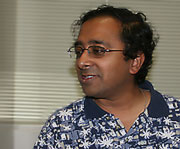

 Skip to navigation
Skip to navigation
Site Primary Navigation:
- About SDSC
- Services
- Support
- Research & Development
- Education & Training
- News & Events
Search The Site:

Published 05/26/2005

Amarnath Gupta, director of the Advanced Query Processing Lab at SDSC, and a coauthor and advisor of best paper author Bin Liu of the Georgia Institute of Technology. |
The judges praised the effort, saying that "this excellent paper presents a very novel system, and essentially opens up a new research area at the intersection of the computer vision and sensor database areas." The winning student receives a prize of $800 as well as free registration for the conference.
Live sensors from simple radio frequency identification (RFID) tags to webcams are becoming common in many applications, producing enormous amounts of continuous data called "media streams." The problem the paper addresses is how to ask questions or "queries" about what is in these live media streams. For example, a scientist studying animal behavior might use digital video to record this behavior, and then want to automate the search for particular behaviors, a task that would be too costly to do manually. Or a bank might want to have an automatic way to check the identity of customers appearing on video at their ATM machines.
However, the overwhelming volume and rate of data in media streams make it impractical to use a sequential process of storing and querying it, and instead require special strategies to query the information as it streams by. Before it is possible to ask questions about the content, various "features" must be extracted. For example, before asking whether a person in the video is smiling, the system must determine whether there is in fact a feature known as a face there at all. But the processing required to extract features introduces time delays of different lengths, and the paper addresses the challenges of how to manage and query multiple features that are identified at different times to produce useful answers. This paper is noteworthy for being one of the first to bring advanced query processing technologies to bear in querying media streams.
The CVDB workshop will be held on June 17 in Baltimore, Maryland as part of the SIGMOD/PODS conference (Special Interest Group on Management of Data/Principles of Database Systems) sponsored by the Association of Computing Machinery (ACM), which is one of the most important database conferences. The workshop bridges the gap between the computer vision and database communities. This facilitates interdisciplinary research by providing database researchers the opportunity to learn about the challenges that computer vision people are working on, and vice-versa, with the aim of defining research directions that benefit both communities. The workshop includes tutorials and presentations along with a panel for exchanging ideas with professional image users and providers, giving the researchers exposure to real-world applications.
More information on the workshop is at http://cvdb05.irisa.fr/.